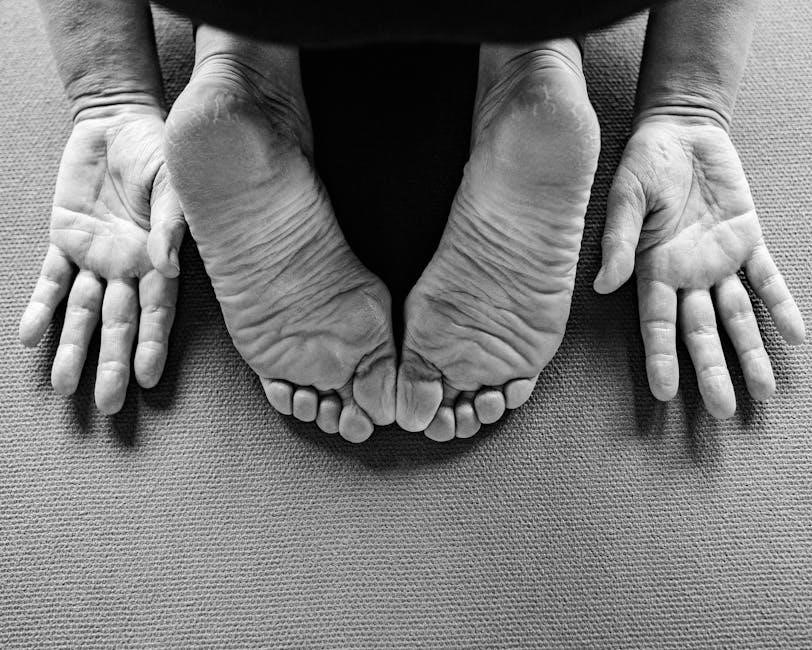Physical therapy is a healthcare profession dedicated to enhancing movement, strength, and overall well-being. It helps individuals recover from injuries, manage chronic conditions, and improve mobility through evidence-based practices, promoting a higher quality of life.
What is Physical Therapy?
Physical therapy is a healthcare specialty that focuses on improving mobility, strength, and function to enhance overall well-being. It addresses a wide range of conditions, from injuries and chronic pain to post-surgical recovery and neurological disorders. Using evidence-based techniques like manual therapy, exercise, and modalities, physical therapists create personalized plans to help patients regain independence and achieve optimal movement. This practice emphasizes non-invasive, patient-centered care, empowering individuals to overcome limitations and improve their quality of life through tailored interventions and education.
The Role of a Physical Therapist
A physical therapist is a licensed healthcare professional who specializes in diagnosing and treating movement-related disorders. Their role involves evaluating patients to identify limitations, creating personalized treatment plans, and implementing therapies to restore function and mobility. Therapists use techniques like exercise, manual therapy, and modalities to address pain, improve strength, and enhance overall well-being. They also educate patients on proper movement, injury prevention, and home exercises. By collaborating with other healthcare providers, physical therapists play a crucial role in helping patients achieve optimal recovery and maintain long-term health.
Benefits of Physical Therapy
Physical therapy offers numerous benefits, including pain management, improved mobility, and enhanced strength. It aids in recovery from injuries, surgeries, or chronic conditions, reducing reliance on medication. Therapy sessions are tailored to individual needs, promoting faster healing and preventing future injuries. By addressing movement limitations, it enables patients to regain independence in daily activities. Additionally, physical therapy improves overall well-being, boosting mental health and quality of life. Regular therapy can also prevent surgeries and reduce healthcare costs, making it a cost-effective and holistic approach to long-term health management.
Common Conditions Treated in Physical Therapy
Physical therapy effectively addresses a wide range of conditions, including musculoskeletal injuries, sports injuries, and post-surgical recovery. It is also used to manage chronic pain, arthritis, and neurological disorders like stroke or Parkinson’s disease. Additionally, PT helps with cardiovascular rehabilitation, balance disorders, and mobility issues related to aging. Conditions such as sciatica, tendonitis, and fibromyalgia are commonly treated. By focusing on movement and function, physical therapy provides relief and restores independence for individuals with diverse health challenges, making it a versatile treatment option for various acute and chronic conditions.

Education and Licensing in Physical Therapy
Physical therapists need a Doctor of Physical Therapy degree, passing the National Physical Therapy Examination, and state licensing. Certifications and continuing education maintain expertise.
Educational Requirements for Physical Therapists
Earning a Doctor of Physical Therapy (DPT) degree from an accredited program is essential. Most programs require a bachelor’s degree with prerequisite courses in sciences and mathematics.
Curricula include anatomy, biomechanics, and neurology, along with clinical internships. Graduates must pass the National Physical Therapy Examination (NPTE) to qualify for licensure and practice as licensed physical therapists.
Licensing and Certification Process
To practice, physical therapists must obtain a state license. Requirements include graduating from an accredited DPT program and passing the National Physical Therapy Examination (NPTE). Some states also require additional exams or criminal background checks. Certification is optional but demonstrates specialized expertise. The American Board of Physical Therapy Specialties (ABPTS) offers certifications in areas like orthopedics or neurology. State licenses must be renewed periodically, often requiring continuing education and adherence to ethical standards. Licensing ensures public safety and maintains professional accountability.
Continuing Education in Physical Therapy
Continuing education is essential for physical therapists to stay updated on advancements and maintain licensure. Most states require a certain number of continuing education units (CEUs) for license renewal. These can be earned through workshops, online courses, or conferences. Topics often include new techniques, research findings, and ethical practices. Continuing education ensures therapists provide evidence-based care and adapt to industry changes. It also supports professional growth and enhances patient outcomes. Staying informed helps therapists remain competent and competitive in their field. Regular learning fosters a commitment to lifelong professional development.

Core Concepts and Techniques in Physical Therapy
Physical therapy combines manual therapy, exercise, and modalities to restore function, reduce pain, and improve mobility. Techniques focus on patient-centered care and evidence-based practices to enhance recovery and overall well-being.
Manual Therapy Techniques
Manual therapy involves hands-on methods to improve joint mobility, reduce pain, and enhance soft tissue flexibility. Techniques include joint mobilization, soft tissue mobilization, and myofascial release. These methods target specific areas to restore movement and reduce stiffness. Physical therapists use these interventions to address limitations in range of motion and muscle imbalances. By applying controlled forces, manual therapy promotes healing, improves posture, and enhances overall functional ability. It is often combined with exercise and education for optimal patient outcomes.
Exercise Therapy and Rehabilitation
Exercise therapy is a cornerstone of physical therapy, focusing on tailored physical activities to restore strength, mobility, and function. It includes strengthening exercises, aerobic conditioning, flexibility training, and balance exercises; These programs are designed to address specific diagnoses, improve movement patterns, and enhance overall physical performance. Progression of exercises ensures continuous improvement, while patient education promotes long-term adherence. Exercise therapy also plays a key role in injury prevention and post-surgical recovery. By engaging patients in active participation, physical therapists empower individuals to achieve independence and optimal health outcomes.
Modalities Used in Physical Therapy
Physical therapy modalities are non-invasive treatments used to enhance healing, reduce pain, and improve function. Common modalities include heat therapy, ice therapy, ultrasound, and electrical stimulation. Heat therapy increases blood flow and relaxes muscles, while ice reduces inflammation and pain. Ultrasound promotes tissue healing, and electrical stimulation strengthens muscles and alleviates pain. Other modalities like TENS (transcutaneous electrical nerve stimulation) and Iontophoresis are also used. These techniques are often combined with exercises to maximize treatment effectiveness, accelerate recovery, and improve patient mobility and comfort.

Patient Assessment and Diagnosis
Patient assessment and diagnosis are critical in identifying conditions and guiding treatment; This phase includes interviews, physical examinations, and diagnostic tests to determine the root cause of symptoms, ensuring accurate diagnosis and effective care plans.
Initial Evaluation and Assessment
The initial evaluation is the first step in physical therapy, involving a thorough patient interview, review of medical history, and physical examination. This phase identifies symptoms, limitations, and functional deficits. Therapists use standardized assessments, including range of motion, strength testing, and gait analysis, to gather data. Diagnostic tests like imaging or lab results may be reviewed. The goal is to pinpoint the root cause of dysfunction, establish a baseline for progress, and guide the development of an effective treatment plan tailored to the patient’s needs and goals.
Diagnostic Criteria and Testing
Physical therapists use diagnostic criteria and specialized tests to identify movement dysfunctions, strength imbalances, and functional limitations. Standardized assessments, such as range of motion measurements, strength testing, and gait analysis, are employed. Patient-reported outcomes, like pain levels and activity limitations, are also considered. These tests help classify conditions, monitor progress, and tailor interventions. While physical therapists do not diagnose medical conditions, their findings guide treatment and inform collaborative care with healthcare providers, ensuring targeted and effective care plans.
Importance of Accurate Diagnosis
Accurate diagnosis is crucial in physical therapy as it ensures targeted and effective treatment. Misdiagnosis can lead to inappropriate interventions, prolonged recovery, or further injury. Precise identification of impairments enables therapists to address the root cause, improving patient outcomes. It also enhances patient trust and satisfaction. Accurate diagnosis supports proper documentation, communication with healthcare providers, and reimbursement processes. By ensuring interventions align with specific needs, it maximizes efficiency and minimizes healthcare costs. Ultimately, it fosters safer, evidence-based practice, leading to better long-term results for patients.

Treatment Plans and Goals
Treatment plans and goals are personalized, time-bound strategies to achieve optimal recovery. Goals are specific, measurable, and patient-centered, ensuring progress and motivation.
Developing a Treatment Plan
A treatment plan is a detailed document outlining the patient’s goals, interventions, and expected outcomes. It is created collaboratively with the patient, ensuring alignment with their needs and priorities. The plan includes specific, measurable objectives, such as improving mobility or reducing pain, and outlines the timeline for achieving them. Physical therapists use diagnostic results, baseline assessments, and patient input to tailor the plan. Regular reassessments allow adjustments to ensure progress toward goals. The plan also incorporates education and home exercises, empowering patients to take an active role in their recovery.
Setting SMART Goals for Patients
SMART goals are Specific, Measurable, Achievable, Relevant, and Time-bound, ensuring clarity and focus in therapy. Specific goals target precise outcomes, like improving knee range of motion. Measurable goals use objective metrics, such as increasing strength by 20%. Achievable goals are realistic based on the patient’s condition. Relevant goals align with the patient’s priorities, like returning to work. Time-bound goals set clear deadlines, such as achieving independence in walking within 12 weeks. These goals guide therapy progress and keep patients motivated, fostering a structured path toward recovery and functional improvement.
Role of Patient Compliance in Therapy
Patient compliance is crucial for effective physical therapy outcomes. It involves adhering to prescribed exercises, attending sessions, and following lifestyle advice. High compliance enhances recovery, improves functional abilities, and reduces treatment duration. Factors influencing compliance include clear communication, patient education, and a strong therapist-patient relationship. Strategies to boost compliance include setting realistic goals, providing feedback, and ensuring the treatment plan aligns with the patient’s lifestyle. Active participation fosters accountability and empowers patients to take charge of their rehabilitation, leading to better long-term results and overall satisfaction.

Emerging Trends in Physical Therapy
Emerging trends include telehealth, wearable technology, and AI integration, enhancing accessibility and personalization of care. These innovations improve outcomes and streamline rehabilitation processes effectively.
Telehealth and Virtual Physical Therapy
Telehealth and virtual physical therapy are revolutionizing care delivery by enabling remote consultations and treatment. Using video calls and digital platforms, therapists can assess patients, demonstrate exercises, and monitor progress in real-time. This approach enhances accessibility, especially for those in remote areas or with mobility challenges. Virtual PT also reduces costs and improves convenience while maintaining high-quality care. Wearable devices and mobile apps further support personalized treatment plans. Despite its benefits, telehealth requires patient engagement and reliable technology to ensure effective outcomes. It serves as a valuable complement to traditional in-person therapy, fostering continuity of care.
Use of Wearable Technology in PT
Wearable technology is transforming physical therapy by enabling real-time monitoring of patient movements and progress. Devices like smartwatches and sensors track metrics such as range of motion, strength, and gait, providing valuable insights for therapists. These tools enhance accuracy in assessments and allow for personalized treatment adjustments. Wearables also promote patient engagement by offering biofeedback and motivation through gamification. Remote monitoring capabilities ensure continuous care, even outside clinic visits. This technology not only improves outcomes but also streamlines communication between patients and therapists, making rehabilitation more efficient and patient-centric.
Role of AI in Physical Therapy
Artificial intelligence (AI) is revolutionizing physical therapy by enhancing diagnostics, treatment planning, and patient monitoring. AI algorithms analyze data from wearable devices and medical records to predict recovery timelines and identify potential risks. It enables personalized treatment plans by adapting exercises based on real-time progress. AI-powered tools also assist in automating routine administrative tasks, allowing therapists to focus on patient care. Additionally, AI-driven assistive devices, like robotic exoskeletons, aid in rehabilitation for patients with severe mobility issues. By improving efficiency and precision, AI is reshaping the future of physical therapy, making it more accessible and effective for diverse patient needs.

Marketing and Practice Growth
Effective marketing strategies are essential for physical therapy practice growth, enhancing online presence, and attracting new patients through digital campaigns and community engagement. Building trust and loyalty drives long-term success and sustainability.
SEO for Physical Therapy Websites
Optimizing your physical therapy website for search engines is crucial for attracting new patients. Start with keyword research to identify terms like “physical therapy near me” or specific treatments. Ensure your website content is keyword-rich, with meta descriptions and titles optimized for search engines. Local SEO strategies, such as creating a Google My Business profile, help patients find your practice easily. Regularly update your site with blogs or patient testimonials to improve rankings. Mobile-friendly designs and fast loading speeds also enhance SEO performance. Track your website’s analytics to refine your strategy and boost visibility.
Importance of Website Design for PT Clinics
A well-designed website is essential for physical therapy clinics to establish credibility and attract patients. A professional appearance builds trust, while user-friendly navigation ensures visitors can easily find information. Mobile responsiveness is crucial, as many users access websites on smartphones. Clear calls-to-action, such as scheduling appointments, encourage patient engagement. Accessibility features, like ADA compliance, ensure your site is usable for all. A modern design with high-quality images and testimonials can differentiate your clinic from competitors. Investing in a polished website enhances patient experience and supports practice growth.
Building Social Media Presence
Building a strong social media presence is vital for physical therapy clinics to connect with patients and promote services. Authenticity fosters trust, while consistent posting keeps audiences engaged. Share educational content, like injury prevention tips, to establish expertise. Patient testimonials and success stories build credibility. High-quality visuals, such as videos of exercises, capture attention. Engage with followers by responding to comments and messages. Collaborating with influencers or other healthcare providers can expand reach. A well-managed social media strategy enhances visibility, attracts new patients, and strengthens community ties, ultimately growing your practice.
Referral Strategies for Physical Therapists
Building strong relationships with physicians, surgeons, and other healthcare providers is key to generating referrals. Offering referral incentives, such as educational resources or workshops, can encourage partnerships. Hosting community events or free screenings increases visibility and trust. Leveraging satisfied patients by asking for referrals and testimonials also boosts word-of-mouth marketing. Providing exceptional care ensures patients refer others. Regularly following up with referring providers to share patient progress strengthens collaboration. Tracking and rewarding referral sources fosters long-term relationships, creating a steady pipeline of new patients and growing your practice.

Ethical and Legal Considerations
Physical therapy practice requires adherence to ethical standards, patient confidentiality, and legal regulations. Maintaining professional integrity, avoiding conflicts of interest, and ensuring informed consent are essential.
HIPAA Compliance in Physical Therapy
HIPAA compliance is critical in physical therapy to protect patient privacy and confidentiality. Physical therapists must safeguard Protected Health Information (PHI) through secure storage and transmission. Breaches can result in fines and reputational damage. Practices must train staff on HIPAA policies, use encrypted systems for records, and ensure patient access to their data. Compliance also involves obtaining proper authorizations and avoiding unauthorized disclosures. Adhering to HIPAA standards builds trust and ensures legal adherence, making it a cornerstone of ethical physical therapy practice.
Importance of Informed Consent
Informed consent is a legal and ethical cornerstone in physical therapy, ensuring patients are fully aware of their treatment options. It fosters trust and transparency, empowering patients to make decisions about their care. Physical therapists must provide clear, understandable information about the proposed treatment, including risks, benefits, and alternatives. This process ensures patient autonomy and protects practitioners from legal disputes. Informed consent is not just a formality but a vital step in building a collaborative patient-therapist relationship, promoting mutual understanding and respect.

Avoiding Burnout in Physical Therapy Practice
Burnout is a common challenge in physical therapy, often due to high patient loads, emotional demands, and administrative tasks. To mitigate this, therapists should prioritize self-care, including time management and stress-reduction techniques. Setting realistic boundaries, seeking mentorship, and engaging in peer support groups can help. Encouraging a healthy work-life balance and pursuing hobbies outside of work are also critical. Regular check-ins with colleagues and supervisors can provide emotional support and practical solutions. Addressing burnout proactively ensures long-term career satisfaction and improved patient care.

Outcome Measurement and Research
Outcome measurement and research are vital for advancing physical therapy practice. They involve assessing treatment effectiveness, identifying best practices, and driving evidence-based care through continuous study and analysis.
Measuring the Effectiveness of Physical Therapy
Measuring the effectiveness of physical therapy involves assessing patient progress and outcomes. This is done through standardized assessments, patient-reported outcomes, and objective measures like range of motion and strength. Data is collected before, during, and after treatment to evaluate improvements in pain, function, and quality of life. Tools such as functional scales and performance tests help quantify progress. Regular monitoring ensures interventions are working and adjustments can be made. Accurate measurement is crucial for evidence-based practice, improving care quality, and demonstrating the value of physical therapy to patients and healthcare systems.
Role of Research in Advancing PT Practice
Research plays a vital role in advancing physical therapy practice by identifying effective interventions, improving treatment outcomes, and guiding evidence-based care. Studies explore new techniques, technologies, and approaches, ensuring therapies are safe and effective. Research also informs clinical decision-making, helping therapists stay updated on best practices. By investigating diverse patient populations and conditions, research broadens the scope of physical therapy, addressing unmet needs and enhancing patient care. Continuous investment in research fosters innovation, ultimately improving the profession’s ability to deliver optimal outcomes and advance the field of physical therapy.
Physical therapy is a vital tool for recovery and wellness; Staying informed about advancements ensures optimal patient care and professional growth. Apply these insights to enhance outcomes.
Summarizing Key Takeaways
Physical therapy is a dynamic, evidence-based practice that enhances mobility and function. Key takeaways include the importance of personalized treatment plans, patient compliance, and ongoing education. Therapists must stay updated on emerging trends like telehealth and wearable technology to improve care. Accurate diagnoses and SMART goals are critical for effective outcomes. Ethical practices, including HIPAA compliance and informed consent, ensure patient trust and legal adherence. Continuous research and outcome measurements guide advancements, ensuring physical therapy remains a vital tool for recovery and wellness.
Resources for Further Learning
For deeper insights into physical therapy, explore resources like the American Physical Therapy Association (APTA) website, which offers courses, webinars, and publications. Journals such as Physical Therapy and Journal of Orthopaedic & Sports Physical Therapy provide evidence-based research. Online platforms like Coursera and YouTube channels like Physiotutors offer educational videos. Additionally, books like Physical Therapy: What It Is and How It Works and professional forums can enhance knowledge. These resources help practitioners stay updated and refine their skills for optimal patient care.